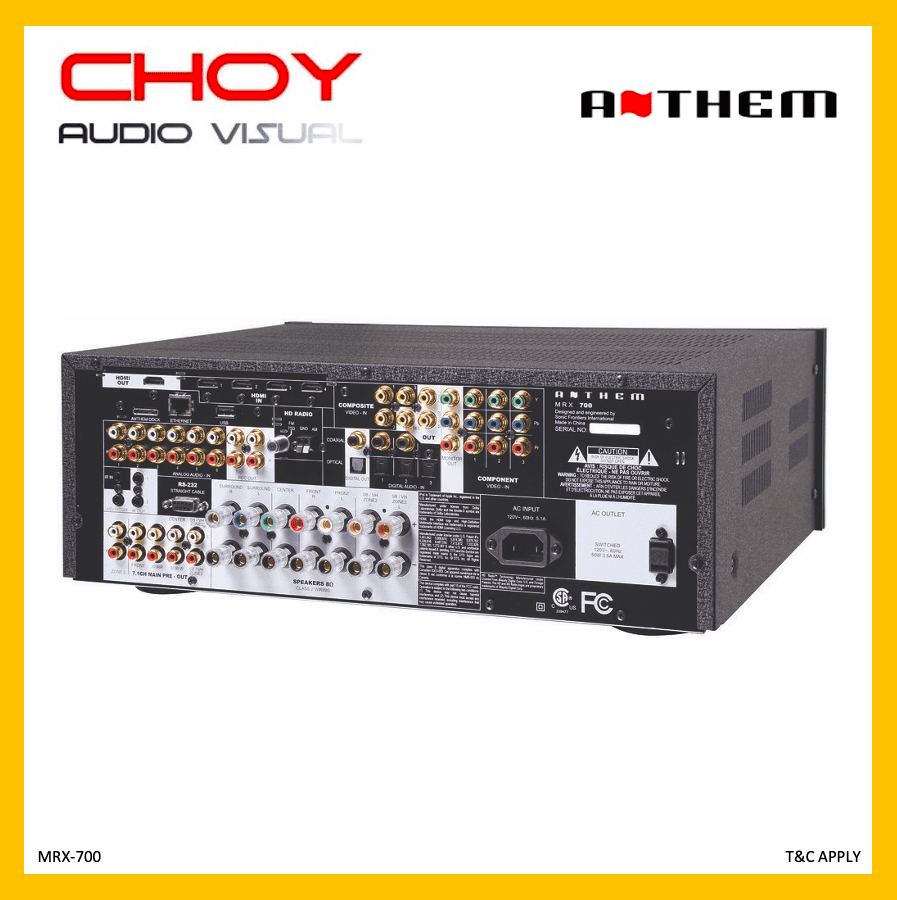- Dolby: TrueHD, Digital Plus, Pro Logic IIx/IIz
- DTS: DTS-HD Master Audio, DTS, Neo:6
- Other: Anthem Logic Music, Anthem Logic Cinema
- 3D: Pending firmware update
- THX Certification: No
- Number of Amp Channels: 7
- Rated Power (watts per channel): 120 watts into 8 ohms, two channels driven; 90 watts into 8 ohms, five channels driven
- Specified Frequency Response: 10 Hz to 30 kHz (+0/–0.5 dB)
- Video Processing: Unspecified
- Auto Setup/Room EQ: Anthem Room Correction
Anthem MRX 700 7.1 A/V Receiver
RM 4,999.00
Description
Anthem MRX 700 7.1 A/V Receiver
It has decoding for all mainstream standard and high-resolution movie and music sound formats, USB inputs with an iPod dock on the way, upscaling to 1080p, Ethernet networking and even a Dolby ProLogic IIz height channel option. But that is your lot for secondary features.
There’s no independent multi-room AV, or Airplay, no bespoke anti-jitter digital link-ups and (at present) no iPad app remote control. There is also an amazing lack of big-name component brands such as Anchor Bay, ISF, Burr-Brown etc, and virtually all the electronics are born and bred in-house at the Paradigm Advanced Research Centre, or PARC.
Most notable of these is Anthem’s own ARC EQ system, notable for being a lightly pared-down version of the ARC system found on the D2V. And that is the best-sounding EQ system of any I am yet to hear by a long, Canadian country mile.
Set-up
Set-up and installation is not necessarily for the faint hearted, though, because the protocols and accepted procedures used by almost all other manufactures have gone right out of the window.
Unlike the competition, that supply a little plastic bodied set-up mic, the MRX range comes with a solid aluminium USB audio mic, an easily adjustable tripod, cables and software for your laptop. The whole set up procedure is controlled from the PC which runs thorough a complete Real Time Analysis (RTA) measurement before applying its comprehensive filters for best stereo music and multichannel movie response curves.
ARC feels so much more flexible on the PC than an in-receiver-based system, and the filtering range runs from 5kHz right down to 20Hz – a lot lower than Audyssey’s effective range. Moreover, the sheer number-crunching power and data storage requirements are moved to a dedicated device (your laptop, notepad, PC etc) offering much greater depth, detail and flexibility in the system.
OK, I admit, the set-up is mind bogglingly complex. The laptop-based EQ will no doubt have some users running for the hills and the onscreen interface is simply not as logical or as well laid out as the slick GUIs on the latest Japanese receivers.
If you do use the setup without the safety net of a dealer installation, I guarantee you’ll be flicking back and forth through the manual wondering why certain things just aren’t working. Still, we like a challenge.
Sound
The 7 x 120W amps are traditional class A/B design, fed from a chunky power supply to ensure plenty of current for big multichannel swells. As per most receivers, the EQ system defaults to being on, but it is worth spending some time with the MRX 700 with the EQ off to start with.
It’s a robust-sounding beast with plenty of ‘oomph’ on tap. The natural stance is a heavyweight balance that delivers a soundstage forged of granite with lead trimmings and ballast in the belly.
With suitably dense and moody movies such as on Blu-ray, the sense of dark foreboding is amplified with crushingly intense effects,and the bass presence threatens to squeeze the air out of your chest. In , as the tooth fairies fly around the auction house, the scale and dimension of the soundstage is perfectly formed, becoming wide, spacious and uncluttered. The effects come fast and furious with the newly dry and tightly focused bass underpinning each one.
As Hellboy unloads round after round at the fairies, the effect is thrilling and immersive, the MRX 700 punching well above its price point in terms of adrenaline-fuelled action.
But while impressive with the right movie, it’s all a bit heavy for or .
Stepping the pace down produces sound that is cleaner, crisper and more infectious with the ARC engaged, bringing life and sparkle to slower-paced movies and Pixar classics alike. Dialogue is precision-crafted ‘front of house’ with admirable tonal accuracy to voices.
Engage the ARC and the effect is nothing short of astonishing. The system’s grip and control of the lower frequencies is stunning, turning phat bass with added room reverb into ultra-tight, mega-punchy effects with lightning-fast transient attack.
Better still, it does this without culling any of the bass power. Quite the opposite in fact! Gunfire has incredible power that will flap your bell-bottoms with every round, and explosions attempt to physically pitch you off the sofa in a sharp-edged wave of percussive violence.
The ARC’s control over the subwoofer in particular is way ahead of the game, making even Velodyne’s excellent built-in EQ on the DD18 sound woolly by comparison.
It’s an incredibly impressive and involving sound, but the ARC does have its limitations on the MRX series. For example, compared to the implementation on the D2V, it’s not quite as sophisticated, and the upper frequency EQ stops at 5kHz.
This means that any top-end issues borne of, say, feisty speakers with too much treble, for instance, or an over-damped room, packed full of Laura Ashley’s finest soft furnishings, are left untouched.
With my elderly Tannoys and their now rather smooth and rolled-off top end, the Anthem MRX 700 never achieved the sheer magic of the full-bandwidth D2V ARC system. That said, it is still very impressive and some seven grand cheaper, too. Cool.
Power consumption: Watts
Idling: 70 Watts – Another AVR that you’re advised to switch off when you’re not using it
Powered: 120 Watts – In five-channel mode and at a comfortable listening level, real world consumption averages 120W
Power ratings: Watts (8Ω, 0.5% THD)
2-channel 8Ω: 135 Watts – Our Tech Labs measured 135W into 8Ω in two-channel mode, which is above Anthem’s specification
5-channel 8Ω: 115 Watts – As expected there is a drop-off in power in five-channel mode to 115W, and to 80W in seven-channel mode
Untainted: Watts
Fidelity firewall: 130 Watts – A measurement of power untainted by distortion (0.03THD, 8Ω, 1kHz), the Anthem is somewhat eclipsed by its Japanese rivals
Signal/noise: dB
S/N tests: 70dB at 20Hz, 70dB at 1kHz and 70dB at 20kHz – A solid measurement across the frequency range













